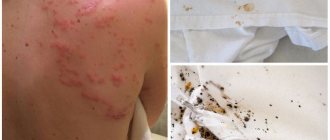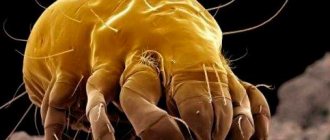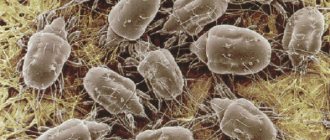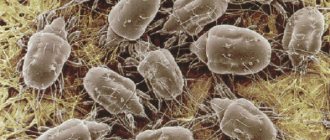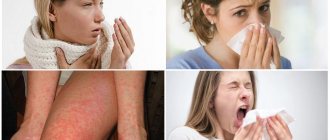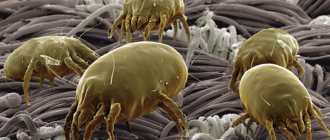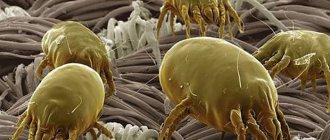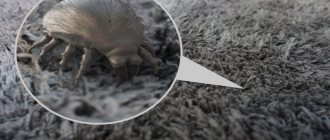- August 31, 2018
- Allergology
- Evdokimova Irina
There are cases when a person regularly experiences unexplained allergy attacks. In this case, it is impossible to identify the irritant. Nowadays, it has been established that the cause of an allergic reaction can be the smallest parasites Dermatophagoides Farinae, living in house dust. How to get rid of them? We will consider this issue in the article.
A little history
In 1964, scientists from Holland and Japan discovered dust mites. They investigated what it was, Dermatophagoides pteronyssinus, and studied the reaction of patients who had sensitivity to house dust. The response from their body was positive. Thus, scientists have found that the presence of mites in house dust is an allergenic factor for people with a genetic predisposition to atopic dermatitis. It was after these discoveries that active study of dust mites began. How to get rid of them at home will be discussed further.
Varieties
Nowadays, there are more than 150 species of dust mites. All of them can be classified in three areas:
1. The first of them find food in house dust and reproduce there. These mites feed on skin scales and particles of microflora living on the skin. These are pyroglyphid mites, as well as granary-grain mites, living in places where cereals and flour are stored. The last of them feed on human products and mold. It is this variety that causes allergies among agricultural workers. There are mites that cause allergic reactions in bakery workers (Acarus siro and Tyrophagus putrscentiae), others (Tyrolichus casei) are responsible for the appearance of “cheese” dermatosis, Glycyphagus domesticus causes dermatitis in grocery workers.
Since the beginning of the 90s, such inhabitants have increasingly begun to be found in people’s apartments. This is due to the storage of large quantities of products in unsuitable premises. People suffering from bronchial asthma acquired sensitization to granary mites, its rate ranged from 6 to 20%.
2. The second type includes predators that eat ticks of the first type. This includes cheyletids, gamasaceae and others.
3. There are also mites that fall into dust by accident, without being able to reproduce there. This is the third variety. Such mites do not survive in human pillows and beds, unlike representatives of the first group. According to experts, they do not cause allergies in people.
Dermatophagoides pteronyssinus - what is it for humans?
This is the designation for pyroglyphide mites that live in house dust and form allergens for humans. They are considered the most harmful to people. How to remove dust mites is a question that worries many allergy sufferers.
The tick's body produces large amounts of protein and other molecules. It is these products of their vital activity that cause allergic pathologies such as:
- allergic rhinitis (symptoms in adults and children are a profuse runny nose);
- atopic dermatitis, neurodermatitis, eczema (skin rashes);
- bronchial asthma (coughing attacks).
In rare cases, the development of systemic anaphylaxis may begin, especially when ingesting foods with a high content of mites and their waste products. Then symptoms such as rhinorrhea, Quincke's edema, and shortness of breath appear.
In response to exposure to tick proteins, IgG antibodies begin to form in the body of sensitive people to block the path of an allergic reaction. In medicine, a technique is used to determine the amount of these antibodies to make a diagnosis in allergy sufferers.
Symptoms
Doctors call an allergy to the waste products of dust parasites dermatophagoidosis. This disease is accompanied by the following symptoms:
- Itching. After skin contact with the area where mites accumulate, redness and irritation of the epidermis occurs. It is accompanied by severe itching. Scratching appears, through which bacteria can penetrate the skin.
- Runny nose. Copious clear discharge comes out of the nose, and sneezing appears.
- Conjunctivitis. Redness of the mucous membrane of the eyes occurs, and increased secretion of tear fluid is noted.
- Asthma attacks. Choking occurs most often in the evenings and disappears after wet cleaning of the room.
Allergic reactions often occur in late summer and early autumn. This is the period of greatest tick activity.
General description and distribution path
The size of these mites is from 0.1 to 0.4 mm; in their development they go through several phases (larva, nymph), and are sexual, that is, they are male or female.
The tick's body produces substances that are allergens for humans. These particles enter the external environment along with feces and accumulate in house dust. The sizes of the balls in which allergens are stored range from 10 to 40 microns, weight is 10-20 ng. Fecal pellets easily become airborne during, for example, cleaning, and then settle on a person’s mucous membranes, thus penetrating the body.
Description of dust mite
It is very difficult to see what a dust mite looks like without special equipment. The size of arthropods reaches 0.1 – 0.5 mm. Under a microscope, you can see that the parasite has a slightly elongated body, 8 legs, and no wings.
The life cycle of a dust mite is 65 to 80 days. Parasites live in large colonies; 1 g of dust can contain from several hundred to several thousand mites. Optimal conditions for the development of dermatophages: air temperature +18… +25⁰С, humidity 70 – 80%. Parasites feed on dead skin particles and dandruff.
Medical names
Nowadays, scientists have discovered and described at least 11 allergens of pyroglyphid mites. They are designated by the names Der1-Der10, Der14. These are mainly digestive enzymes.
For example, the mite allergen Dermatophagoides pteronyssinus often causes a hypersensitivity reaction in humans. Simply put, this is an allergy to house dust. In response to the presence of mites, a person may also experience rhinorrhea, shortness of breath, Quincke's edema, and allergic rhinitis. Symptoms in adults and children will be similar.
Reasons for appearance
Dermatophagoides Farinae and Pteronyssinus mites are found in almost any living space. Their concentration increases sharply and becomes hazardous to health in the following cases:
- when cleaning the house rarely;
- if there are a large number of carpets, upholstered furniture, plush toys in the room;
- when keeping animals in the house (ticks can live on their fur);
- with rare ventilation of the room, infrequent washing and drying of clothes and bedding.
Dust parasites live in the house even if it is perfectly clean. However, regular cleaning and hygiene significantly reduce their numbers.
Where do they live?
The described dust mites are distributed throughout the planet. They are located by scientists in all corners of the globe. And in all countries there are people who have a hypersensitivity reaction to mite allergens. Doctors call such people sensitized.
According to one hypothesis, pyroglyphid mites appeared in people's homes from bird nests. At first they populated the nests of birds, and then, together with the feather, they found their way into human homes. It's no wonder that mites are found in pillows these days.
People themselves contribute to the spread of ticks. They bring them on shoes and clothes, with used furniture, soft toys.
Ticks are found not only in homes, but also in childcare centers, hotels, hairdressers, laundries, sanatoriums, on buses (in soft seats), trains (in mattresses).
How do you know if there are dust mites in your apartment?
It is impossible to visually detect dust mites in a house or apartment. You can only see a parasite on a sofa or blanket with the help of a powerful magnifying glass, and only if you know where to look. But the immune system helps a person determine the presence of parasites. Allergy symptoms that occur in response to the presence of dust mites indoors:
- constant nasal congestion;
- frequent sneezing, coughing in the absence of a cold;
- dyspnea;
- loss of appetite;
- red rashes on the skin;
- itching;
- swollen eyelids, inflamed eyes.
Signs of parasites
The most accurate method is the use of special patch tests to determine the concentration of parasites. The kit includes a dust collector, test strips, chemical reagents and a scale for calculating the degree of contamination. It is prohibited to use such tests on people or pets living in an apartment.
Where do dust mites live?
Dust mites spread throughout the room, but there are still places where they accumulate the most. These include:
- cushioned furniture;
- bedding (mattresses, pillows, blankets);
- carpets;
- Stuffed Toys;
- cloth;
- soft house shoes;
- corners and crevices where dust accumulates (including crevices in the floor under carpeting, under baseboards);
- books and bookshelves;
- pet beds.
In addition, dust mites live in the dust bags of vacuum cleaners.
Do pillows harbor dust mites?
There is a theory that dust mites originally appeared in bird nests. Over time, they settled among poultry - chickens and geese, and then, with their feathers stuffed into feather beds and pillows, they entered human homes.
Over time, a large number of keratinized skin particles accumulate in pillows, so mites settle there in huge colonies. Ticks, especially often found in the house, live in pillows filled with natural down or feathers.
In the apartment
In modern apartments, the distribution of ticks is uneven. Most of them can be found in the bedroom, namely in the bed. Optimal conditions for their life are created here - a temperature of about 25 degrees and a humidity of 75%.
The number of ticks may vary depending on the apartment, the location in it, and also changes at different times of the year. The largest number of mites that was recorded by experts in Moscow apartments is 13,000 individuals per gram of dust.
What affects the number of ticks in an apartment?
Scientists say that the number of mites living in house dust directly affects the occurrence of hypersensitivity in people. If there are more than 100 individuals for each gram of dust, this leads to the appearance of an allergy in a person who has a genetic predisposition to it. If there are more than 500 mites per gram of dust, this situation can provoke an attack of bronchial asthma.
Scientists have found that the increase in the number of ticks in an apartment is associated with seasonality. Most of them are in late August - early October. It is at this time that patients with allergies discover their most frequent manifestations.
Dust mites: how to get rid of them at home?
To control the number of ticks, various methods are used: mechanical, physical, chemical.
In any case, treatment against ticks should be carried out after a specialist has examined the apartment and found out the exact number of ticks. The use of household chemicals in the apartments of patients suffering from allergies should be extremely careful.
Special acaricidal products are produced that are recommended for the fight against house dust mites. A specialist can help you choose the right one. Such preparations guarantee the rapid death of all ticks in the apartment.
Washing bedding at high temperatures and baking them in the summer sun helps in the fight against ticks. Weak solutions of bleach or salt, which are used to treat surfaces, are also recommended as folk remedies.
So, we found out that it is Dermatophagoides pteronyssinus. This is the most common type of house dust mite. The study of this issue remains relevant for patients who have a similar type of allergic reaction in the body.
Allergy to house dust - what to do?
The first step in dealing with any type of allergy is to minimize exposure to the allergen. You will have to work hard for this. Dust must be removed not only in the room of the person suffering from allergies, but throughout the entire house.
Rule #1
Throw out the “dust collectors”! Replace them with items that are unfavorable for ticks:
- Avoid fur skins, canopies, etc.;
- Replace curtains with blinds or curtains that can be easily washed in hot water;
- It is advisable to replace furniture with fabric upholstery with leather;
- In your apartment design, avoid various decorative details (figurines, etc.) on which dust accumulates;
- Store books in a glass cabinet;
- Do not allow your child to take soft toys to bed;
- Avoid down, flannel and lint;
- Don't keep decorative pillows in your bedroom;
- Choose pillows, mattresses and blankets made from synthetic fibers that are highly airy and dry well;
- Avoid carpets or rugs; parquet or linoleum is enough;
- Don't get large indoor plants.
Rule #2
The bedroom is a favorite place for dust mites. Therefore, it needs to be given special attention. The bedroom should be cool. Overheated air dries out the mucous membranes, causing an exacerbation of rhinitis and bronchial asthma. In addition, dust does not settle for hours in dry air.
Choose and care for bedding correctly:
- Ventilate your bed well, don't just remake it. The mattress should be vacuumed daily; air the sheets, beat blankets and pillows - at least twice a week.
- If you prefer natural fillings for pillows and duvets, choose products with the “NOMITE” label (they are suitable for use by people with dust mite allergies);
- Use products for treating upholstered furniture, carpets, mattresses, etc., as well as laundry additives that destroy mite and epidermal allergens (mostly cat allergen);
- Wash bed linen 1-2 times a week in hot water (temperature above 60 degrees) or use special laundry additives;
- Cover pillows, blankets and mattresses with protective covers made of special fabric, having previously treated them with the above-mentioned products. They are fastened with a special small zipper with an internal protective strip. The cover should cover the mattress on all sides.
Rule #3
When you use a regular vacuum cleaner, dust particles and allergens are released into the air and do not settle for hours. All this time the person inhales them. Vacuum cleaners with HEPA filters have been developed especially for allergy sufferers, which prevent an increase in the concentration of allergens in the air. In addition to the HEPA filter at the output, a filter is required after the motor. You can also use vacuum cleaners that are equipped with dust collectors with thick walls and a valve system, and vacuum cleaners with aqua filters (if equipped with HEPA filters). Washing vacuum cleaners can only be used with anti-allergenic and acaricidal additives.
When cleaning, adhere to the following rules:
- Vacuuming should be done at least 2 times a week;
- You have to clean it very carefully. Spend 1.5-2 minutes per half square meter of surface. Vacuum folds, buttons, and decorative stitches especially carefully;
- It is better that the allergy sufferer is not at home while cleaning. If you vacuum yourself, wear a mask to protect your skin and mucous membranes.
Rule #4
It is necessary to maintain optimal humidity in the house and carry out air purification:
- Humidity should be 40-60%. Use a humidifier and do wet cleaning more often, especially during the heating season;
- You can reduce the concentration of allergens in the air using an air purifier, which should preferably be used continuously (therefore it should not produce harmful substances);
- Change the filters in your air purifier on time;
- An air conditioner or ionizer cannot replace a purifier.
Rule #5
Patients with dust mite allergies may have cross-reactions to a number of foods. Be careful with shrimp, crabs, crayfish, snails, and clams.
Rule #6
If you are allergic to house dust, consult an allergist. Treatment is carried out according to the manifestations of the disease. Allergic rhinitis is treated in one way, bronchial asthma in another, etc. The basis of treatment is reducing contact with the allergen. If these measures are ineffective, specific immunotherapy (SIT) is recommended. The method consists of subcutaneously injecting an allergen extract in increasing concentrations at certain intervals.
If you suffer from an allergy to house dust, contact the Oberig Universal Clinic. Make an appointment with an allergist by phone.
